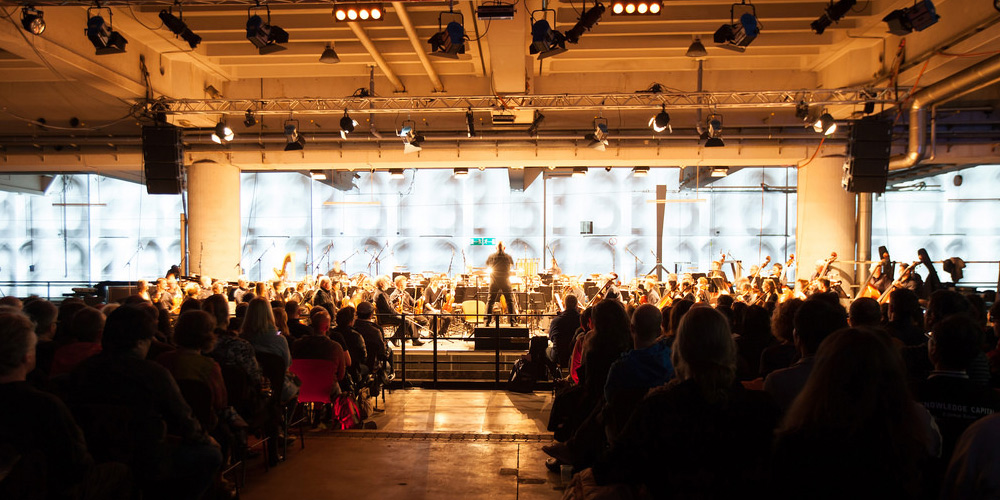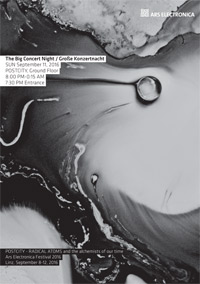
The musical highlight of every Ars Electronica Festival is the Big Concert Night. Launched in 2002 by Dennis Russell Davies, chief conductor of the Bruckner Orchestra, this is an encounter of classical music, electronic sound artistry and computer-generated visualizations. The impressive venue of this year’s extraordinary concert is POSTCITY’s huge Train Hall.
SCHEDULE
| 7:30PM Audible Entrance | Sam Auinger (AT/DE): GLEISHALLE – Ambient 1 |
| 8PM | Simone Zaunmair (AT): La Lucha Performed by Bruckner Orchester Linz (AT)/ Dennis Russell Davies (US/AT) |
| 8:15PM | Marc Reibel (AT):Rendez-vouz avec Claude Performed by Bruckner Orchester Linz (AT) / Dennis Russell Davies (US/AT) Visualisation by Akiko Nakayama (JP) |
| 8:30PM Spiral Falls | FM Einheit (DE): Mene, Mene, Tekel, upharsin |
| 9:20PM | Maurice Ravel (FR): Ma mére l’Oye Performed by Bruckner Orechester Linz (AT) / Dennis Russell Davies (US/AT) Visualization by Ars Electronica Futurelab |
| 9:50PM | Igor Stravinsky (RU): Le Sacre du Printemps Performed by Bruckner Orchester Linz (AT) / Dennis Russell Davies (US/AT) Visualization by Cori O´lan (AT) |
| 10:30PM | XBlade Allstars get Radical: Drone Race |
| 10:35PM Break, Train Hall | Sam Auinger (AT/DE): GLEISHALLE – Ambient 2 |
| 10:55PM | AROTIN&SERGHEI (AT/RU), Mikhail Rudy (RU/FR): Light Impulse – Radical Atoms1016/ Vers la Flamme 1914 |
| 11:25PM | AGF (DE): The Radical Self |
| 11:45PM | Sam Auinger (AT/DE) / Hannes Strobl (AT/DE) (tamtam): GLEISHALLE – a concert Cycle |
La Lucha
Simone Zaunmair (AT)
Performed by Bruckner Orchestra Linz (AT)/ Dennis Russell Davies (US)
La Lucha – entre dos hombres celosos y la mujer describes two jealous men fighting over a woman. A fervent, pompous duel in the profuse Mariachi-Macho style—compassionate trombone solos alternate with demanding trumpet passages and powerful orchestral crescendos. Furious, quick and rousing! A story full of passion, pain, pride and melancholy, set amidst Mexico—or wherever it might come to such a clash.
Rendez-vous avec Claude
Marc Reibel (AT)
Performed by Bruckner Orchestra Linz (AT) / Dennis Russell Davies (US)
Visualization by Akiko Nakayama (JP)
My composition took shape 20 years ago, written under the powerful influence of Wolfgang Dauner, to whom it is dedicated. It combines a single theme in the style of Claude Debussy with elements from the jazz, rock and funk genres.Over the course of what is tantamount to a musical journey with Claude through the 1970s and ‘80s, the theme is constantly cast in a new light. Embedded in between are improvised instrumental solos that are additionally enriched by the personality of the respective musicians performing them.
Mene, Mene, Tekel, upharsin
FM Einheit
Numbered, weighed and found wanting. Blinded by his unbounded power, Babylonian King Belshazzar hosted a great feast. At the height of the gala celebration, he commanded that the gold and silver vessels stolen from the Jewish Temple be brought forth so the revelers could drink from them in honor of Baal, the god of Babylon. No sooner were they desecrated than a disembodied hand appeared and wrote the following words in flaming letters on the palace wall: Mene, Mene, Tekel, upharsin. Thus began the downfall of Babylon. The decommissioned postal service logistics center’ spiral packet chutes—custommade for the facility in the 1980s—invite festivalgoers to decipher the mysterious inscription. The construction—made to vibrate in its distinctive resonance—sorts materials hidden beneath the skin of their packaging, packets encircling the globe millions of times daily. And once again we pay homage to the gods of consumption. The results of this acquisitive frenzy are spewed out by the spiral packet chutes, and festivalgoers can number and weigh them for themselves and perhaps find them wanting.
Ma mére l’Oye
Maurice Ravel (FR)
Performed by Bruckner Orchester Linz (AT)/ Dennis Russell Davies (US)Visualization by Ars Electronica Futurelab (AT)
Ma mère l’Oye is part of a five-piece suite inspired by the works and fairytales of Charles Perrault, Marie-Catherine d’Aulnoy and Jeanne Marie Leprince de Beaumont. The French composer Maurice Ravel originally dedicated Ma mère l’Oye (Mother Goose),
a piano piece for four hands, to Mimi and Jean Godebski, six and seven years old.
The piano duet premiered at the first concert of the Société Musicale Indépendante on April 20, 1910. In 1911 Ravel adapted and extended the piano duet to a suite for orchestra. It then was first performed at the Aeolean Hall by the New York Symphony Orchestra on November 8, 1912, and in this form Ma mère l’Oye is most frequently heard.
Le Sacre du Printemps
Igor Stravinsky (RU/FR/US)
Performed by Bruckner Orchester Linz (AT) / Dennis Russell Davies (US)Visualization by Cori O’lan (AT)
Le Sacre du Printemps (The Rite of Spring) was composed by Igor Stravinsky in 1913. The main theme is suggested by its subtitle, Pictures of Pagan Russia in Two Parts: to please the god of spring a young girl is chosen as a sacrificial victim and dances herself to death. Le Sacre du Printempswas written for the 1913 Paris season of Sergei Diaghilev’s Ballets Russes company with an original choreography by Vaslav Nijinsky. Despite nowadays being one of the best-known orchestra pieces of all time, at the time its premiere at the Théâtre des Champs-Élysées caused a scandal. The sharp dissonances and peculiar rhythms of Stravinsky’s piece were not what the listeners expected. Only later reception saw Le Sacre du Printemps as the visionary and highly influential masterpiece that it is.
Light Impulse—Radical Atoms 2016 / Vers la Flamme 1914
AROTIN & SERGHEI (AT/RU), Mikhail Rudy (RU/FR)
Real-time sound and video animation with a performance of late piano works Op. 72-74 by Alexander Scriabin.
Light Impulse is based on the radical innovative concept of the composer Alexander Scriabin (1872-1915), creator of a light notation system for a fictitious “Light Piano” and inventor of a “synthetic mystic hexachord” origin of all possible sounds. Together with Mikhail Rudy, a pianist and specialist in Scriabin’s oeuvre and Russian avant-gardes, AROTIN & SERGHEI bring this vision to the future, showing the visual impulses and transmutation of radiant atomized sounds and light particles in the subliminal cell structures of “Infinite Screen”.
In cooperation with the Museum in Progress, Klangforum Wien, Wiener Konzerthaus, Ars Electronica, Biennale di Venezia, Fondation Beyeler Basel and the Kunsthistorisches Museum Vienna. Installation and Performance: AROTIN & SERGHEI; Piano: Mikhail Rudy
The Radical Self
AGF (DE)
AGF {poemproducer} performs works from ‘Kon:3p>UTION to: e[VOL]ution’, ‘The Self / The Other’ and ‘if*true~time[x]1+2=you.\<‘ The RADICAL SELF. shadow musical systems. beat structure per minute. action networks. sculpted sound. THE self / the OTHER. voice noise. sonic umwelt. rhyme greim. network-mycelium. radical friendships. transformation capa-cities. wildness re-club flexion. fluxion. flux-internetness. glitch cyborging. public reverberation. non-human spaciouness. capita-lis-monsters. vision-wither-beauty. poetess extravanganza. breaking the grid. to ACT. ACTION: love enforcement.
XBlade Allstars get Radical
Drone Race
The Tornado XBlades, current World Champion Drone Racing Team will perform a FPV (First Person View) demonstration race through a dystopian industrial night course during the Big Concert Night. Screaming high tech drones sampled as digital sounds while travelling at speeds up to 120kmh will fuse with orchestral music, live electronics and projected visualizations to create a dazzling introduction to this exploding Sport.
GLEISHALLE – a concert cycle
Sam Auinger (At/DE) & Hannes Strobl (AT/DE) aka tamtam
Idea / Concept: Sam Auinger
Composed and performed by: Sam Auinger & Hannes Strobl aka tamtam, including the compositional element of a tuning tube by: Bruce Odland & Sam Auinger aka O + A
Artistic support: Katrinem and Stefan Weissenberger
Technical support: Thomas Koch and Gerd Thaller
“Imagine, a space starts to talk to you, but not with words and strings of meaning instead in changing states and moods (by sound), you can sit, lie down or walk in it.”
The space is the instrument is the space. Its specific idiosyncrasy, its tonal, vocal and acoustic qualities constitute the object of attention of this concert cycle. A series of concerts of varying duration and staged at different times during the festival’s run engenders on site a tonal space that plays with visitors’ perception of space and time, and the emotional perceptibility of the space.
The Instrument / The Space
The spatial configuration of the Gleishalle makes it an extraordinary setting for sensory perceptions within the context of everyday experience. This indoor space is a former railroad freight—car loading/ unloading dock for the transshipment of letters and parcels. The form and materiality of the architecture follows its function (logistics operations). The space’s dimensions—more than 200 meters long, about 50 meters wide, less than 8 meters high—determine two of its fundamental auditory traits: a resonance time of approximately six seconds, and an audible topography.
The Cycle
In music, a cycle is a multi-part composition with a shared context of meaning. The parts normally represent variations on a theme. The Gleishalle with its specific auditory qualities is the theme of this concert cycle. The space’s specific quality is primarily the result of its unusual spatial proportions. Here, a sound (acoustic event) fades away in the width and length of the space and not in its height too, as we’re familiar with in comparably vast spaces such as cathedrals—for example, St. Mary’s (Mariendom) in Linz. The Composition The space’s extraordinary characteristics with respect to architecture and materiality will be interrelated to a loudspeaker system so as to bring about the development of a compositional language. This will create the possibility of organizing acoustic events in such a way that audience members can partake of various auditory experiences: spatial coloration, spatial density, spatial depth, spatial movements and spatial states, both stable and unstable.


